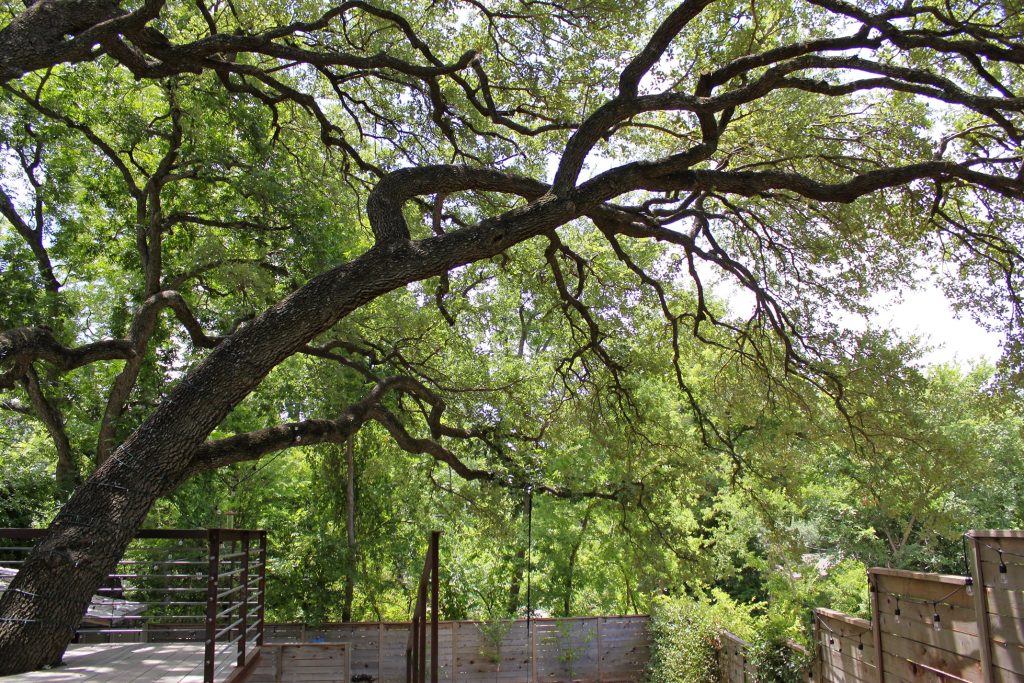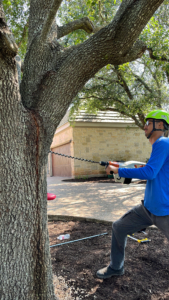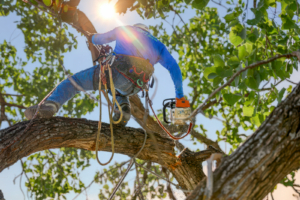Tree Service Buda TX & ISA-Certified Arborist | Expert Tree Care
- Tree Removal, Tree Planting, and Tree Trimming
- Certified Arborists
- Emergency Services
Call Today to Schedule an Appointment. 512-212-0010
Call Today to Schedule an Appointment. 512-212-0010
Buda has grown fast—but its trees haven’t always had the time or support to keep up. With new subdivisions springing up beside old ranch lots and established neighborhoods, tree care needs across Buda are as diverse as the landscape itself. Native oaks and mesquite trees battle drought and compacted soil, while newer plantings need careful guidance to establish strong roots in tough conditions. Add in seasonal storms and the growing risk of oak wilt, and it becomes clear that generic tree work just doesn’t cut it.
At Happy Tree Service of Austin, we offer more than one-time trims or quick removals. We deliver science-first tree care built specifically for Buda’s environment. Whether you’re a homeowner protecting a backyard oak or a property manager overseeing community trees, we provide certified evaluations, safe pruning, and long-term plans that keep your trees healthy and your property safe year after year.

From native Texas hardwoods to ornamental species in new builds, our arborists bring hands-on knowledge, credentials, and care to every tree we manage. We don’t treat your trees like a weekend chore—we treat them like living assets that deserve professional stewardship.
Tree care starts with understanding tree biology, and every member of our crew is trained and led by an ISA Certified Arborist. That means your property is evaluated and serviced by someone who knows how local trees grow, how they respond to pruning, and how to spot early signs of disease or decline. This level of certification is what separates professional care from general labor.
Oak wilt is a constant concern across Buda, and we’re trained to catch it early. Our team includes Texas Oak Wilt Qualified arborists who know how to identify symptoms, recommend safe pruning schedules, and prevent further spread. We’re also Tree Risk Assessment Qualified—so if you’re worried about a tree leaning over a driveway or showing signs of decay, we can evaluate it for structural stability and safety.
For more than 30 years, we’ve worked with oaks, elms, mesquites, Florida maples, red bays, and sassafras trees across the Austin Metro. We understand how trees interact with drought stress, rocky soils, wind exposure, and rapid development. That experience informs every cut we make and every plan we build for long-term canopy care.
When trees show signs of stress, we don’t just guess—we diagnose. Our process may include soil analysis, tissue sampling, root collar inspection, or aerial assessments, depending on the problem. We also consult with labs like Texas A&M’s Plant Pathology team to verify diseases and guide treatments. Our knowledge is continually updated, and we bring that to your property every time we visit.
Happy Tree is known across Central Texas for clean worksites, clear communication, and consistent results. Whether we’re trimming a single cedar or managing dozens of HOA trees, we respect your time, your landscape, and your trust. That’s why homeowners, builders, and property managers in Buda call us again and again—not just for one job, but for every season.
 Tree Trimming and Pruning That Prevents Damage and Supports Growth
Tree Trimming and Pruning That Prevents Damage and Supports GrowthTree trimming in Buda requires more than aesthetics. In a region prone to wind storms, heat stress, and sudden limb drop, proper pruning can make the difference between a healthy tree and a hazard waiting to happen. We trim to protect, strengthen, and shape each tree based on its structure and setting.
Heavy canopies put strain on major limbs, especially during wind events or under drought stress. We use targeted crown thinning to reduce weight without compromising canopy health. This helps prevent cracking, splitting, and long-term structural failure.
If your grass won’t grow under your oak or your flower beds are constantly shaded, canopy density may be the culprit. By thinning carefully selected interior branches, we open space for light to reach the ground—without overexposing the tree or weakening its structure.
Overhanging limbs pose risks to siding, gutters, parked cars, and pedestrian paths. We create safe clearance zones around structures, walkways, and roadways while preserving the tree’s shape. Our crews are especially mindful near roofs, solar panels, fences, and backyard features like pergolas or fire pits.
Trees planted in new neighborhoods often lack the structural guidance needed to grow upright and stable. We provide early corrective pruning for saplings and young trees, helping them develop strong branch unions and ideal shape before problems take root.
Some trees can’t be saved. Whether they’ve been struck by lightning, overtaken by oak wilt, or are simply growing too close to a home or utility line, removal may be the only safe option. Our certified removal services are built around safety, planning, and minimal disruption.
Our risk assessments include checking for trunk rot, root flare movement, canopy dieback, and structural imbalance. If a tree presents an immediate hazard or shows signs of internal decay, we walk you through your options clearly, including removal and potential replacement.
In tight lots, near fences, or on uneven terrain, we use controlled rigging systems to take trees down piece by piece. This ensures branches don’t fall where they shouldn’t—and your landscape stays intact. We’re especially cautious near pools, gardens, and outdoor structures.
Central Texas storms can uproot trees, split trunks, or bring down massive limbs with little warning. We provide emergency tree service across Buda to address immediate hazards, stabilize trees, and begin the cleanup process safely. We prioritize safety over speed—but we do both efficiently.
After removal, we don’t just leave a mess behind. We clear debris, haul away limbs, and rake the site for loose material. For businesses or HOAs, we can also provide safety reports, tree inventories, and health evaluations for surrounding trees that may need follow-up care.
Leaving a stump behind doesn’t just spoil your view—it can become a hazard, attract pests, or get in the way of replanting. Our stump grinding services eliminate what’s left and restore the area for your next landscaping goal.
We grind stumps well below the surface to make room for new trees, garden beds, or turf. Whether you’re planning to plant again or just want the lawn back, we remove the root flare and grind the surface until it’s flat and safe.
Decaying wood attracts insects and can harbor fungal growth. Stump grinding removes that decay zone and eliminates the regrowth that often sprouts from unaddressed root systems.
In residential yards, stumps interfere with play, mowing, and aesthetics. In commercial or shared spaces, they become liability risks. Grinding ensures that the removal is truly complete—and that your landscape is ready for whatever comes next.
 Tree Planting Designed for Buda’s Conditions
Tree Planting Designed for Buda’s ConditionsBuda’s mix of compacted development soil, native clay, and patchy drainage means that not every tree will thrive here without help. Choosing the right species and planting it properly makes a measurable difference—not just for growth, but for long-term safety, stability, and appearance.
We guide homeowners, builders, and HOAs toward tree species that are well-suited to Buda’s terrain and climate. Native options like live oak, mesquite, and red bay are resilient choices, while adaptive ornamentals such as Mexican sycamore or Chinese pistache can offer seasonal color and canopy value without added risk. Every recommendation takes into account the soil depth, site layout, and maintenance expectations of the property.
Where a tree is planted affects how well it grows—and how long it lasts. We assess site conditions like sun exposure, slope, and drainage flow before selecting a planting location. In newer subdivisions with narrow side yards or street trees, we ensure there’s enough room for both canopy expansion and future root growth. For custom homes or larger lots, we help balance visual goals with practical spacing.
A common mistake we see is planting trees too deep, which can choke the root flare and lead to premature decline. We plant every tree with the flare exposed and apply mulch in a proper, donut-style ring—not piled against the trunk. This protects the root zone while allowing airflow and moisture regulation, critical in the first few years after planting.
New trees need extra care to get established in Buda’s demanding climate. We provide custom watering schedules and optional starter fertilization to reduce transplant shock and promote early growth. Our ISA Certified Arborists also offer follow-up evaluations in the first 12 to 18 months to check on progress and advise on corrective pruning or care.
The health of a tree starts below ground. In Buda’s compacted or construction-disturbed soil, roots often lack the oxygen, nutrients, and room they need to thrive. That’s why we offer science-based, below-surface treatments designed to restore balance and unlock growth.
Before we treat the soil, we test it. Trees showing signs of yellowing, leaf loss, or slow growth may be suffering from nutrient lockout, mineral deficiencies, or pH imbalance. By collecting lab-analyzed samples, we can target treatments that match the problem—not mask it.
We inject a slow-release blend of macronutrients and trace elements directly into the root zone to promote stronger growth and better resistance to environmental stress. This is especially helpful for trees in high-traffic areas or yards that experience heavy irrigation, which can deplete or dilute soil nutrients over time.
When soil becomes too dense for roots to breathe or absorb moisture, we use an air-spade to break it up without damaging the tree. This tool uses high-pressure air to gently remove compacted earth and expose the root collar for inspection or intervention. We often use this technique in established neighborhoods or homes built on former pastureland.
These treatments are best suited for trees already showing signs of stress—especially if they were planted during construction, located near driveways or footpaths, or installed in poor fill soil. We also recommend root-zone work for trees impacted by recent storm damage or drought stress.
Oak wilt remains one of the top threats to native trees in Central Texas—and Buda is no exception. Our team is Texas Oak Wilt Qualified and trained to diagnose, treat, and contain this deadly fungal disease before it can spread across property lines or shared landscapes.
Red oaks typically show quick decline, including browning leaf margins, leaf drop, and rapid canopy dieback. Live oaks may decline more slowly, often starting with leaf thinning and branch dieback. If you notice sudden changes in a tree’s health, especially during the spring or early summer, it’s worth getting it inspected right away.
Oak wilt is most often spread by beetles that are attracted to fresh pruning wounds. To minimize transmission, we only prune oaks during the safe window between July and January. If storm damage or structural risks require out-of-season cuts, we seal every wound immediately as a preventative measure.
Our oak wilt treatment plans begin with confirmation—through both visual diagnostics and, when needed, lab testing. If treatment is appropriate, we may recommend fungicide injection, root trenching, or the removal of infected red oaks. These steps help prevent the disease from spreading through root grafts or spore contact.
Because oak wilt doesn’t respect fences, containment often requires a coordinated response. We work with HOA boards, neighboring homeowners, and property managers to develop strategies that include mapping infections, setting pruning restrictions, and notifying nearby properties. Community-level coordination is one of the most effective ways to reduce the long-term impact of this disease.
Not every flawed tree needs to be removed. Some trees can be preserved—and protected—with the right kind of structural support. We provide cabling and bracing services for trees that show weaknesses but still offer value, shade, or character to a property.
Our arborists assess trees with multiple trunks, V-shaped unions, or prior storm wounds to determine if they can be supported. We consider canopy weight, wind exposure, and previous limb drop before recommending cabling or bracing as an alternative to removal.
For suitable trees, we install steel support systems in the upper canopy or between major limbs to reduce movement and lessen the risk of failure. These systems are designed to shift the stress of heavy limbs and allow trees to move safely in the wind without splitting or tearing.
Support systems require periodic evaluation. We include long-term monitoring and adjustment in every cabling or bracing project, ensuring the tree’s structure continues to respond well as it grows. If future removal becomes necessary, we’ll guide you through that process with transparency and care.
Caring for trees in Buda means planning for more than just this season—it means preparing for wind, drought, soil challenges, and disease threats across years. At Happy Tree Service of Austin, we don’t just trim or remove trees—we provide proactive, certified care for long-term safety and health.
Whether you’re planting a new tree, removing a hazard, or managing a full canopy across an HOA or business park, we’re here to help. Our ISA Certified Arborists bring knowledge, tools, and respect to every job. Call today to schedule a free consultation and let us show you what a trusted, science-first tree care partner can do for your property in Buda.